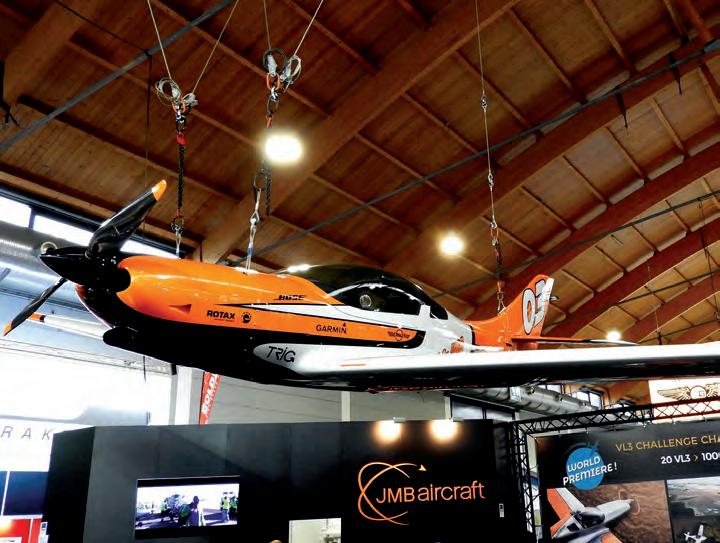
9 minute read
PROJECT NEWS
Projects which inspire others to build their own aircraft Compiled by Mike Slaughter
Project News
Aquick peek in the New Projects this month reveals the usual recurring favourites, plus a couple of unusual types. The first that caught my eye is a Volmer VJ-22 Sportsman, a late 1950s two-seat high-wing amphibian, designed around a pair of redundant Aeronca wings with a wooden fuselage ‘hull’. There was an example built some years ago that I believe used to operate in Scotland. The second rare beast is a Jurca Sirocco, again there’s only one other currently on the UK register – Peter Watts’ retractable variant, G-CEAO, which has featured in an LA flight test. There were at least a couple of fixed-gear versions flying in the past, G-AZOS being one of them, now showing as permanently withdrawn from use. The Sirocco is a low-wing two-seat tandem with a bubble canopy of all wooden construction, like a wooden RV-8. It’s a Marcel Jurca design from the 1960s – a real little fighter, especially the retractable variant. Dudley Pattison has provided another update on his current KFA Safari project, it is starting to look close to finished. If you were fortunate enough to get along to the Rally, you may have seen Sprite Aviation’s completed and flying KFA Safari there. Technology, as ever, plays an increasing role in our projects, and Mark Goodacre has applied modern thinking to the process of laying out his panel. While I’m sure he’ll not be the first to have used CAD software to design a panel, he’s taken the further step of cutting it out with his own CNC router. Take a look at his report below, perhaps you too have employed a modern twist in part of your building process, if so your fellow members would love to hear about it!
To get in touch with Project News, and tell your story, report a milestone or just to send a picture, email: projectnews@laa-archive.org.uk. Please share your story!
KFA Safari update (LAA 402 – 15670) By Dudley Pattison

Above This shot shows the removable fibreglass boot cowl and windscreen giving excellent access to the rear of the instrument panel. The VZ Rotax engine is ready for hoisting into position. Photo: Dudley Pattison My Safari build is nearing the end, but I am in no rush to finish it as we head toward winter. Many obstacles, Covid-19 among them, have conspired to keep me from flying my last build, an RV-7A, and as I only have room for one aircraft in my hangar the
RV will have to be sold when it is time to transport the
Safari to the field. So, my intention is to fly the RV throughout the winter and sell it in March. The Safari build has been the usual mix of pleasure and frustration, the most recent source of angst being the fact that I cannot get the flaperons working properly at the moment, but I did have a light bulb moment yesterday and I think I have found the problem. Stefan, the owner of
KFA, sent me some short videos via WhatsApp giving the flaperon set-up sequence, which helped identify an error
I had made. I haven’t had time to rectify it yet but have high hopes that all will be well when I do. Flaperons are new to me, and I confess to having difficulty in getting my head around the geometry involved. Not reading the instruction also resulted in extra work on the undercarriage. When I covered and painted the undercarriage legs, I fitted them to the fuselage and added the wheels and disc brakes before realising that

Left The boot cowl has been removed and the also removable inner fibreglass ‘sidewall’ is seen in position.
Photo: Dudley Pattison

the two raking struts that aim up toward the centre of the fuselage bottom, should have had streamlined fibreglass fairings added. So, a fair amount of struggling around on the floor was involved in the fitting of them and the preparation for paint. I had to wait for the right conditions to spray the struts outside and carry out a fair amount of masking. The engine and cowl installation went smoothly, although I did add some expense to the project by opting for numerous Camlocs to fix the upper cowl to the lower cowl instead of the 6mm screws and rivnuts supplied. This cuts down the time for cowl removal dramatically. Good access to the forward fuselage is afforded by a removable ‘boot’ cowl and inner wall panels, making Above This shot was taken at the time of writing, late August. I am lucky to have a large garage which is a godsend when it comes to rigging time. Photo: Dudley
Pattison.
working on the instrument panel and fuel system easier. The present position is that the fuselage is levelled, with the wings and empennage fitted, while the control movements are sorted. When that is done, I will add all the finishing bits like wingtips, cowls, spats etc. to do the weight and balance. The aircraft will then be derigged and stored in the garage, awaiting the spring. My car has to fend for itself outside while the aircraft is rigged, but when the wings are off it is allowed back inside. Everyone asks me what the Germanic shield is that I put on many of my aircraft and why I use it. As far as I am aware it is the emblem of the Brandenburg Gate, and it is used because I like it!
G-CMAP (LAA 323-15449) Van’s RV-7 By Mark Goodacre
Mark purchased his RV-7 empennage in 2017, but the project got off to a slow start as he had just sold his farm and moved into town. The farm had its own runway that suited his earlier project, a Zenair 750, but it would have been rather short for the RV. Once he’d finished his house renovations and built a workshop in the garden, it was time to get on with the RV, just as lockdown struck, so the project suddenly received a lot of focus. The kit was a Quick Build, so there was no fuselage or wing structure to build. The aircraft has a sliding canopy, and many have commented upon the stress and worry of cutting and glassing this large and difficult to replace component. At one point in the process Mark feared he had permanently glassed it shut, due to a lack of release agent, but it all came out well in the end. The aircraft was painted in a friend’s industrial-sized greenhouse in the spring, using the opening rooflights to regulate the temperature between 20-25°C. Mark did all the preparation and base coats himself, but enlisted the help of a competent sprayer for the final finish. In an unusual twist, panel layout being a big part of most modern projects, Mark was keen to learn a new skill, so he taught himself Fusion 360, a CAD software package that’s free for personal use. This would allow him to evolve the panel design onscreen, and to a high level of accuracy, without the need of the more traditional cardboard template method. Having learned to drive Fusion and perfected his panel design, the next logical step was to buy a small CNC machine to cut it out with. Following a period of research, Mark settled on the UK designed and manufactured Ooznest WorkBee. This would be able to take the CAD files directly and cut a panel from them. He found that he needed to learn a lot about tool paths, cutting speeds and depths. If a router bit was advanced too quickly or the cut too deep, then aluminium would melt, ball and adhere to the cutter, effectively ruining it. So, the skill of applying the WorkBee to the task of cutting aluminium sheet into a finished instrument panel was to learn these parameters by trial and error. To prove the process of cutting a panel, Mark settled upon hardboard as the perfect material for test runs. Excluding time for tool changes, the average panel can be cut in about 30 minutes. Larger apertures are cut to final size and shape whereas smaller holes are drilled as a pilot hole for simplicity and to cut down on tool/bit changes, these are simply drilled out conventionally upon completion. Part of the justification for spending the time and money on producing just one panel by this elegant, and might we say expensive method, was to provide a service to other members, cutting first their panel on a trial fit basis in hardboard and then in the final material – for a small consideration of course!
Below top left The canopy is a stressful part of the RV-7 build. Photo: Mark
Goodacre.
Below top right A hardboard proof cut on the WorkBee, stout enough to be offered up to the aircraft for a trial fit.
Photo: Mark Goodacre.
Below bottom right
The finished panel looks very smart and professional. Photo:
Mark Goodacre.


Above The Ooznest WorkBee CNC router that Mark used to cut the panel. Photo: Ooznest Ltd



Above The -7 at Spanhoe, the paint and the sliding canopy were certainly worth the effort. Photo: Mark Goodacre
New Projects
If your aircraft has been featured in the New Projects list, please let Project News know of your progress at: projectnews@laa-archive.org. uk
n Volmer VJ-22 Sportsman (LAA 293-15780)
17/8/2021
Cleared To Fly
If your aircraft has featured recently in the magazine and has subsequently completed its maiden flight, Project News would like to hear from you at: projectnews@laa-archive.org.uk
n G-CKVJ Titan T51 Mustang (LAA
355-14781) 25/8/2021
Mr Christopher Firth, Glass House One, 16 Havelock Walk, London, SE23 3HG n G-CLRI Zenair CH 750 Cruzer (LAA
381A-15635) 20/8/2021
Mr James Wardlow, 2 Old Poplar Farm Cottages, Kirkby Lane, Tattershall, Asterby, Lincolnshire, LN4 4PD n Van’s RV-10 (LAA 339-15777) 3/8/2021 Mr D McLeod, 1 Woodland Drive, Nocton, Lincolnshire, LN4 2BQ n Van’s RV-8 (LAA 303-15782) 31/8/2021 Mr Myles, 4 Lambourn, Wolfhill, Perthshire, PH2 6TQ n Jurca Sirocco (LAA 059-15778) 2/8/2021 Mr C M Barnes, Lowbrook Farm, Semere Green Lane, Dickleburgh, Norfolk, IP21 4NT n Van’s RV-14A (LAA 393-15779) 17/8/2021 Name & Address held by LAA Engineering
Mr John Evans, The Cottage, Main Street, North Muskham, Newark, NG23 6HQ n G-CLYH Van’s RV-12iS (LAA 363A-15653)
20/8/2021
Mr Matthew Thorne, 1 Cley View, Pound Street, Warminster, BA12 8NS n G-CMAP Van’s RV-7 (LAA 323-15449)
13/8/2021
Mr Mark Goodacre, 6 Beverley Gardens, Stamford, PE9 2UD n G-NGBB Bristell NG5 Speed Wing (LAA
385-15712) 26/8/2021
Mr Tony Palmer, Palmers Farm, Lower Dicker, Hailsham, BN27 4AT & Mr Fary Sayyah, 2 Colgate Close, Crawley, RH11 0AZ n G-CLLN Pietenpol Air Camper (PFA
047-11340)
Name & Address held by LAA Engineering n G-PEEE Van’s RV-7 (s/n 70463) Name & Address held by LAA Engineering n G-STES Europa XS (PFA 247-13931) Name & Address held by LAA Engineering










